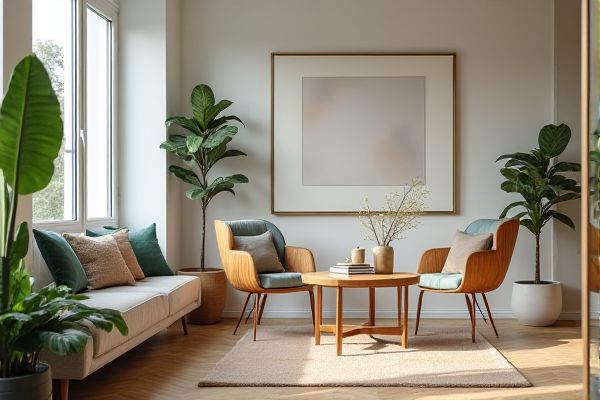
Glass tables offer a sleek, modern aesthetic with easy cleaning and light-reflecting properties, making spaces appear more open; wood tables provide warmth, durability, and timeless appeal with various grain patterns and finishes to match your decor. Discover how to choose the ideal table that fits Your lifestyle and enhances your living space in the rest of the article.
Table of Comparison
| Feature | Glass Table | Wood Table |
|---|---|---|
| Material | Tempered or laminated glass | Solid wood or engineered wood |
| Durability | Scratch-resistant but prone to cracks | Highly durable, scratches can be repaired |
| Maintenance | Easy to clean; requires regular wiping | Needs polishing and protection from moisture |
| Weight | Generally lighter, easy to move | Heavier and sturdy |
| Aesthetic | Modern, sleek, and versatile | Classic, warm, and natural |
| Cost | Moderate to high | Varies from low to high depending on wood type |
| Environmental Impact | Recyclable but energy-intensive production | Renewable if sourced sustainably |
Introduction: Glass Table vs Wood Table
Glass tables offer a modern, sleek aesthetic with transparent surfaces that enhance room brightness and create a sense of spaciousness. Wood tables provide timeless durability, natural warmth, and a variety of grain patterns that add character and complement traditional or rustic decor. Choosing between glass and wood tables depends on preferences for maintenance, style, and the desired ambiance in living spaces.
Aesthetic Appeal: Modern vs Classic Styles
Glass tables offer a sleek, modern aesthetic with clean lines and a transparent surface that enhances light flow and creates a sense of openness in contemporary interiors. Wood tables provide a classic appeal through rich textures, natural grains, and warm tones, lending a timeless elegance suited for traditional or rustic decor. Choosing between glass and wood depends on whether the desired style emphasizes minimalist modernity or enduring classic charm.
Durability and Longevity
Glass tables, made from tempered glass, offer high resistance to scratches and heat, ensuring durability but may be prone to shattering under heavy impact. Wood tables, especially those crafted from hardwoods like oak or maple, provide exceptional longevity through natural strength and the ability to be refinished multiple times. Maintenance plays a crucial role; wood requires periodic sealing to prevent moisture damage, while glass demands regular cleaning to maintain clarity and surface integrity.
Maintenance and Cleaning Requirements
Glass tables require regular cleaning with non-abrasive, streak-free glass cleaners to maintain their clarity and shine, while wood tables need periodic dusting and polishing with wood-specific products to prevent drying and cracking. Glass surfaces are more resistant to stains and spills, making them easier to wipe down quickly compared to wood, which can absorb liquids and suffer damage without timely care. Your choice between glass and wood should consider how much time you want to devote to ongoing maintenance and cleaning routines.
Safety Considerations
Glass tables require tempered or laminated glass to reduce the risk of shattering and potential injuries, making safety a critical factor in their design. Wood tables offer inherent stability and are less prone to breaking or causing injury in everyday use, especially in homes with children or pets. Proper maintenance, such as checking for sharp edges on glass tables and ensuring wood tables are free from splinters, further enhances safety in both.
Cost Comparison
Glass tables generally cost more upfront than wood tables due to the specialized manufacturing process and material quality. Wood tables offer a wider price range, from affordable options made of pine to high-end hardwood designs, making them more budget-friendly for various settings. Your choice depends on balancing initial investment with durability and style preferences.
Versatility and Design Flexibility
Glass tables offer exceptional versatility and design flexibility, seamlessly blending with various interior styles from modern to minimalist by providing a sleek, transparent surface that enhances light and space. Wood tables bring warmth and timeless appeal, allowing for customization through different finishes and wood types to match rustic, traditional, or contemporary decor. Your choice between glass and wood will depend on whether you prioritize a light, airy aesthetic or a cozy, natural ambiance in your living space.
Environmental Impact and Sustainability
Glass tables typically have a higher environmental impact due to energy-intensive manufacturing processes and the non-biodegradable nature of glass production waste. Wood tables, especially those made from sustainably sourced or reclaimed timber, offer greater sustainability by being renewable, biodegradable, and often carbon-neutral over their lifecycle. Your choice will influence resource consumption, with wood being the more eco-friendly option when certified by organizations like FSC (Forest Stewardship Council).
Suitability for Different Spaces
Glass tables suit modern, minimalist interiors, enhancing light flow and creating an illusion of spaciousness ideal for small or compact rooms. Wooden tables provide warmth and durability, making them perfect for traditional, rustic, or cozy spaces where a sturdy, classic centerpiece is desired. Your choice depends on the space's style and functional needs, with glass offering sleek aesthetics and wood delivering timeless comfort.
Final Verdict: Choosing the Right Table Material
Glass tables offer a sleek, modern aesthetic with easy maintenance and a sense of spaciousness, ideal for contemporary interiors and smaller spaces. Wood tables provide durability, natural warmth, and timeless appeal, suitable for rustic, traditional, or cozy environments. Selecting the right table material depends on lifestyle needs, design preferences, and maintenance willingness, balancing style with functional durability.
 homyna.com
homyna.com